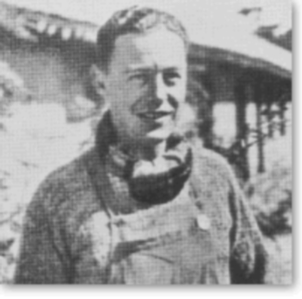Name George Hogg Role Adventurer | Books I See a New China | |
 | ||
Similar People Roger Spottiswoode, Radha Mitchell, Rewi Alley, Simon van der Borgh, Kym Barrett | ||
George hogg photo tribute 1920 2017
George Aylwin Hogg (26 January 1915 – 22 July 1945) was a British adventurer. He was a graduate of Oxford University in economics. He is known as a hero in China for saving 60 orphaned boys during the Second Sino-Japanese War, including leading them 700 miles (1,100 km) through dangerous mountain passes, escaping the approaching Japanese and Chinese Nationalist secret police in the Shaanxi area.
Contents
- George hogg photo tribute 1920 2017
- children of huang shi george hogg living louder
- Early life
- Life in China
- Shandan Bailie School
- Relocation
- Death
- Legacy
- Books
- References
children of huang shi george hogg living louder
Early life
George Aylwin Hogg was the son of Robert Hogg a merchant tailor from Belfast, Co. Antrim & his wife Kathleen née Lester. Hogg grew up in the small town of Harpenden in the United Kingdom. He attended St. George's School, Harpenden, where he was head boy. Afterwards, he went to Wadham College in Oxford, obtaining a degree of Bachelor of Arts. He then became a freelance journalist for the Manchester Guardian.
In 1937 he sailed on the Queen Mary to New York City, hitchhiked across the United States, and joined his aunt Muriel Lester (a well-known English pacifist and friend of Mahatma Gandhi). They continued their trip to Japan.
Life in China
Hogg was an independent reporter for the Associated Press. In January 1938, during the undeclared war between China and Japan, he left Japan to visit Shanghai, China for two days. He helped Kathleen Hall, a nurse from New Zealand, smuggle food and medicine to the communists. During this, he witnessed first hand the brutality of the Imperial Japanese Army towards the Chinese and chose to stay in China. In Shaanxi Province, Hogg befriended communist General Nie Rongzhen and participated with the Eighth Route Army in guerrilla raids against the Japanese. While on the front lines, he wrote the book "I See a New China".
There is an objection to the above. According to the original author of this movie, James MacManus, he was a teacher who kept the children from war. Teacher was vocation. MacManus said "His entry to china was February 1938. He did not go to Nanjing. The movie has been dramatized. It's not the fact." He wrote travel writings. But articles that he saw atrocities have not been found in the archives of Associated Press and United Press International.
Shandan Bailie School
Hogg started to assist the Gung Ho movement operated by New Zealand-born communist Rewi Alley in Shaanxi. He helped Alley operate a lice-infested facility (without books, beds or food) for 60 orphaned boys. He converted a nearby cottage into a dormitory. With credit established in town, he was able to supply millet and vegetables to the children.
The boys called him Ho Ke. To get respect and control over the boys, Hogg participated in many activities with them, including singing, swimming, sports and hiking. The children tended a vegetable garden for food and Hogg made a basketball court for recreation.
He adopted four boys (brothers: Nie Guangchun, Nie Guanghan, Nie Guangtao and Nie Guangpei).
Funds came from the Chinese Industrial Cooperatives (CIC), also organised by Alley. CIC regional headquarters in Baoji was 60 miles (97 km) over the Qinling Mountain pass. Hogg occasionally traveled by bicycle to CIC.
Late 1944, the Nationalist army searched classrooms for boys to recruit. The army arrested Hogg for resisting recruitment.
Relocation
Hogg then decided to relocate the boys to Shandan in Gansu Province 700 miles (1,100 km) away. The first half (33) left in November 1944 and in January 1945, the remaining 27 boys followed. They travelled heavily snow-covered mountain roads by foot.
After a month of travel by foot, 450 miles (720 km), they arrived in Lanzhou. Hogg hired six diesel trucks to complete the trip.
Early March 1945, Hogg and his boys arrived in Shandan. Alley rented some old temples, turned them into classrooms and workshops, and appointed Hogg as headmaster. From the beginning the school was helped by New Zealand friends, who later formed the New Zealand China Friendship Society.
Death
In July 1945, Hogg stubbed his toe while playing basketball with the boys. It became infected with tetanus and two boys went to Lanzhou by motorcycle, a 500-mile round trip to get medicine. To comfort Hogg until he died, the boys sang nursery rhymes he had taught them.
He died on 22 July after three days. He was laid to rest outside town. His headstone is engraved with lines from his favourite poem.
He never saw the end of the Sino-Japanese War with the surrender of Japan just one month after his death.
Legacy
An abridged and modified account (eliminating Alley and modifying Hall) of his life and adventure is portrayed in the feature film The Children of Huang Shi (2008), also called Children of the Silk Road or Escape from Huang Shi, starring Jonathan Rhys Meyers as Hogg and Chow Yun-fat as the intelligence agent Chen Hansheng.
His life is chronicled in Ocean Devil: The Life and Legend of George Hogg by James MacManus. His own account is George Aylwin Hogg, I See a New China, which includes his participation in the Chinese Industrial Cooperatives project in rural industrialization.
Hogg is also a popular topic of study for students at his old school, St Georges in Harpenden.
